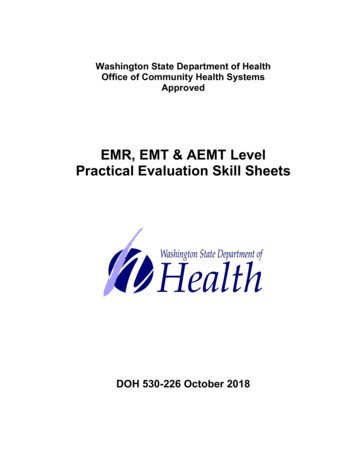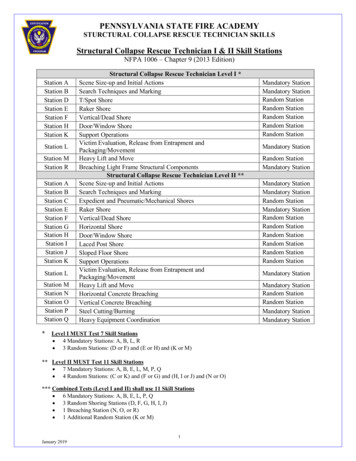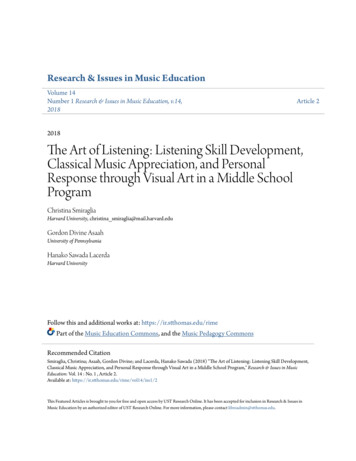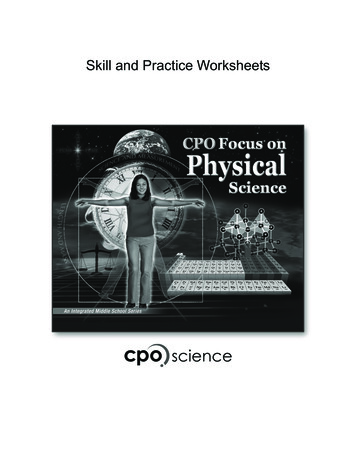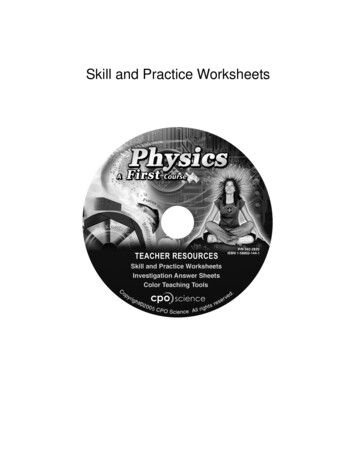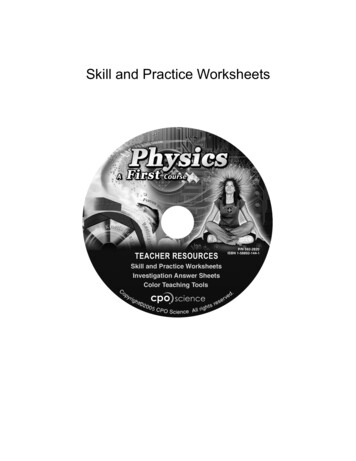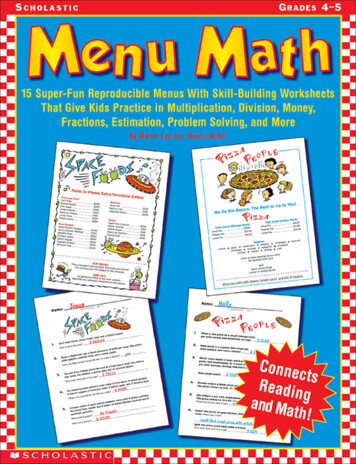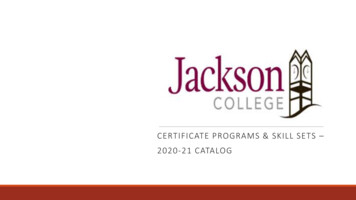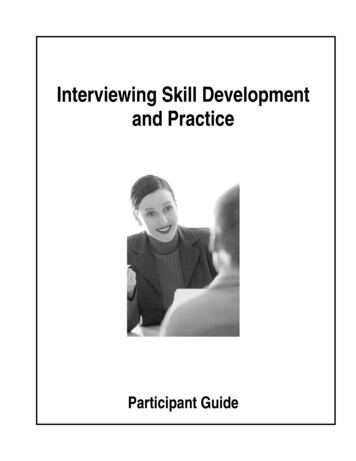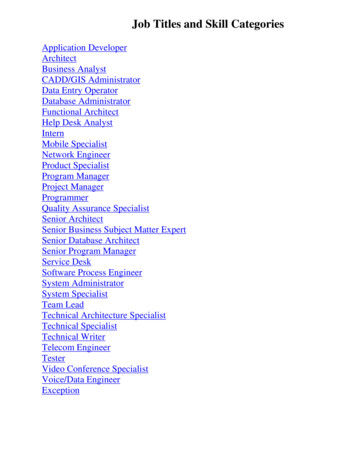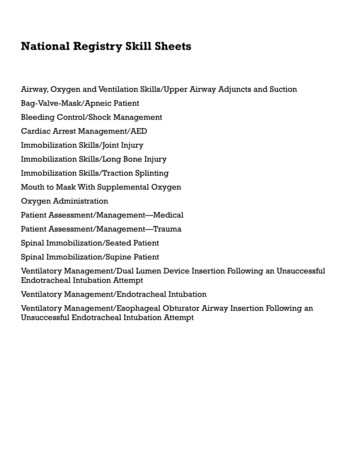
Transcription
National Registry Skill SheetsAirway, Oxygen and Ventilation Skills/Upper Airway Adjuncts and SuctionBag-Valve-Mask/Apneic PatientBleeding Control/Shock ManagementCardiac Arrest Management/AEDImmobilization Skills/Joint InjuryImmobilization Skills/Long Bone InjuryImmobilization Skills/Traction SplintingMouth to Mask With Supplemental OxygenOxygen AdministrationPatient Assessment/Management—MedicalPatient Assessment/Management—TraumaSpinal Immobilization/Seated PatientSpinal Immobilization/Supine PatientVentilatory Management/Dual Lumen Device Insertion Following an UnsuccessfulEndotracheal Intubation AttemptVentilatory Management/Endotracheal IntubationVentilatory Management/Esophageal Obturator Airway Insertion Following anUnsuccessful Endotracheal Intubation Attempt
Emergency Care and Transportation of the Sick and Injured, Ninth EditionNational Registry Skill SheetsAirway, Oxygen and Ventilation SkillsUpper Airway Adjuncts and SuctionStart Time:Date:Stop Time:Candidate’s Name:Evaluator’s Name:PointsPossibleOROPHARYNGEAL AIRWAYTakes, or verbalizes, body substance isolation precautions1Selects appropriately sized airway1Measures airway1Inserts airway without pushing the tongue posteriorly1Note: The examiner must advise the candidate that the patient is gagging and becoming consciousRemoves the oropharyngeal airway1SUCTIONNote: The examiner must advise the candidate to suction the patient’s airwayTurns on/prepares suction device1Assures presence of mechanical suction1Inserts the suction tip without suction1Applies suction to the oropharynx/nasopharynx1NASOPHARYNGEAL AIRWAYNote: The examiner must advise the candidate to insert a nasopharyngeal airwaySelects appropriately sized airway1Measures airway1Verbalizes lubrication of the nasal airway1Fully inserts the airway with the bevel facing toward the septum1TOTAL:CRITICAL CRITERIADid not take, or verbalize, body substance isolation precautionsDid not obtain a patent airway with the oropharyngeal airwayDid not obtain a patent airway with the nasopharyngeal airwayDid not demonstrate an acceptable suction techniqueInserted any adjunct in a manner dangerous to the patient13PointsAwarded
Emergency Care and Transportation of the Sick and Injured, Ninth EditionNational Registry Skill SheetsBag-Valve-MaskApneic PatientStart Time:Date:Stop Time:Candidate’s Name:Evaluator’s Name:PointsPossibleTakes, or verbalizes, body substance isolation precautions1Voices opening the airway1Voices inserting an airway adjunct1Selects appropriately sized mask1Creates a proper mask-to-face seal1Ventilates patient at no less than 800 ml volume(The examiner must witness for at least 30 seconds)1Connects reservoir and oxygen1Adjusts liter flow to 15 liters/minute or greater1The examiner indicates arrival of a second EMT. The second EMT is instructed to ventilate the patientwhile the candidate controls the mask and the airwayVoices re-opening the airway1Creates a proper mask-to-face seal1Instructs assistant to resume ventilation at proper volume per breath(The examiner must witness for at least 30 seconds)1TOTAL:11CRITICAL CRITERIADid not take, or verbalize, body substance isolation precautionsDid not immediately ventilate the patientInterrupted ventilations for more than 20 secondsDid not provide high concentration of oxygenDid not provide, or direct assistant to provide, proper volume/breath(more than two (2) ventilations per minute are below 800 ml)Did not allow adequate exhalationPointsAwarded
Emergency Care and Transportation of the Sick and Injured, Ninth EditionNational Registry Skill SheetsBleeding Control/Shock ManagementStart Time:Date:Stop Time:Candidate’s Name:Evaluator’s Name:PointsPossibleTakes, or verbalizes, body substance isolation precautions1Applies direct pressure to the wound1Elevates the extremity1Note: The examiner must now inform the candidate that the wound continues to bleed.Applies an additional dressing to the wound1Note: The examiner must now inform the candidate that the wound still continues to bleed.The second dressing does not control the bleeding.Locates and applies pressure to appropriate arterial pressure point1Note: The examiner must now inform the candidate that the bleeding is controlledBandages the wound1Note: The examiner must now inform the candidate the patient is now showing signs and symptomsindicative of hypoperfusionProperly positions the patient1Applies high concentration oxygen1Initiates steps to prevent heat loss from the patient1Indicates the need for immediate transportation1TOTAL:CRITICAL CRITERIADid not take, or verbalize, body substance isolation precautionsDid not apply high concentration of oxygenApplied a tourniquet before attempting other methods of bleeding controlDid not control hemorrhage in a timely mannerDid not indicate a need for immediate transportation10PointsAwarded
Emergency Care and Transportation of the Sick and Injured, Ninth EditionNational Registry Skill SheetsCardiac Arrest Management/AEDWith Bystander CPR in ProgressStart Time:Date:Stop Time:Candidate’s Name:Evaluator’s Name:PointsPossibleASSESSMENTTakes, or verbalizes, body substance isolation precautions1Briefly questions the rescuer about arrest events1Turns on AED power1Attached AED to the Patient1Directs rescuer to stop CPR and ensures all individuals are clear of the patient1Initiates analysis of the rhythm1Delivers shock1Directs resumption of CPR1TRANSITION1Gathers additional information about arrest event1Confirms effectiveness of CPR (ventilation and compressions)1INTEGRATIONVerbalizes or directs insertion of a simple airway adjunct (oral/nasal airway)1Ventilates, or directs ventilation of, the patient1Assures high concentration of oxygen is delivered to the patient1Assures adequate CPR continues without unnecessary/prolonged interruption1Continues CPR for 2 minutes1Directs rescuer to stop CPR and ensures all individuals are clear of the patient1Initiates analysis of the rhythm1Delivers shock1Directs resumption of CPR1TRANSPORTATIONVerbalizes transportation of patientTOTAL:CRITICAL CRITERIADid not take, or verbalize, body substance isolation precautionsDid not evaluate the need for immediate use of the AEDDid not immediately direct initiation/resumption of ventilation/compressions at appropriate timesDid not assure all individuals were clear of patient before delivering each shockDid not operate the AED properly (inability to deliver shock)Prevented the defibrillator from delivering indicated stacked shocks120PointsAwarded
Emergency Care and Transportation of the Sick and Injured, Ninth EditionNational Registry Skill SheetsImmobilization SkillsJoint InjuryStart Time:Date:Stop Time:Candidate’s Name:Evaluator’s Name:PointsPossibleTakes, or verbalizes, body substance isolation precautions1Directs application of manual stabilization of the shoulder injury1Assesses motor, sensory and circulatory function in the injured extremity1Note: The examiner acknowledges “motor, sensory and circulatory function are present and normal.”Selects the proper splinting material1Immobilizes the site of the injury1Immobilizes the bone above the injured joint1Immobilizes the bone below the injured joint1Reassesses motor, sensory and circulatory function in the injured extremity1Note: The examiner acknowledges “motor, sensory and circulatory function are present and normal.”TOTAL:CRITICAL CRITERIADid not support the joint so that the joint did not bear distal weightDid not immobilize the bone above and below the injured siteDid not reassess motor, sensory and circulatory function in the injured extremity before and after splinting8PointsAwarded
Emergency Care and Transportation of the Sick and Injured, Ninth EditionNational Registry Skill SheetsImmobilization SkillsLong Bone InjuryStart Time:Date:Stop Time:Candidate’s Name:Evaluator’s Name:PointsPossibleTakes, or verbalizes, body substance isolation precautions1Directs application of manual stabilization of the injury1Assesses motor, sensory and circulatory function in the injured extremity1Note: The examiner acknowledges “motor, sensory and circulatory function are present and normal”Measures the splint1Applies the splint1Immobilizes the joint above the injury site1Immobilizes the joint below the injury site1Secures the entire injured extremity1Immobilizes the hand/foot in the position of function1Reassesses motor, sensory and circulatory function in the injured extremity1Note: The examiner acknowledges “motor, sensory and circulatory function are present and normal”TOTAL:CRITICAL CRITERIAGrossly moves the injured extremityDid not immobilize the joint above and the joint below the injury siteDid not reassess motor, sensory and circulatory function in the injured extremity before and after splinting10PointsAwarded
Emergency Care and Transportation of the Sick and Injured, Ninth EditionNational Registry Skill SheetsImmobilization SkillsTraction SplintingStart Time:Date:Stop Time:Candidate’s Name:Evaluator’s Name:PointsPossibleTakes, or verbalizes, body substance isolation precautions1Directs application of manual stabilization of the injured leg1Directs the application of manual traction1Assesses motor, sensory and circulatory function in the injured extremity1PointsAwardedNote: The examiner acknowledges “motor, sensory and circulatory function are present and normal”Prepares/adjusts splint to the proper length1Positions the splint next to the injured leg1Applies the proximal securing device (e.g., ischial strap)1Applies the distal securing device (e.g., ankle hitch)1Applies mechanical traction1Positions/secures the support straps1Re-evaluates the proximal/distal securing devices1Reassesses motor, sensory and circulatory function in the injured extremity1Note: The examiner acknowledges “motor, sensory and circulatory function are present and normal”Note: The examiner must ask the candidate how he/she would prepare the patient for transportationVerbalizes securing the torso to the long board to immobilize the hip1Verbalizes securing the splint to the long board to prevent movement of the splint1TOTAL:14CRITICAL CRITERIALoss of traction at any point after it was appliedDid not reassess motor, sensory and circulatory function in the injured extremity before and after splintingThe foot was excessively rotated or extended after splint was appliedDid not secure the ischial strap before taking tractionFinal immobilization failed to support the femur or prevent rotation of the injured legSecured the leg to the splint before applying mechanical tractionNote: If the Sagar splint or the Kendricks Traction Device is used without elevating the patient’s leg, application of manual traction is not necessary. Thecandidate should be awarded one (1) point as if manual traction were applied.Note: If the leg is elevated at all, manual traction must be applied before elevating the leg. The ankle hitch may be applied before elevating the leg and usedto provide manual traction.
Emergency Care and Transportation of the Sick and Injured, Ninth EditionNational Registry Skill SheetsMouth to Mask With Supplemental OxygenStart Time:Date:Stop Time:Candidate’s Name:Evaluator’s Name:PointsPossibleTakes, or verbalizes, body substance isolation precautions1Connects one-way valve to mask1Opens patient’s airway or confirms patient’s airway is open (manually or with adjunct)1Establishes and maintains a proper mask to face seal1Ventilates the patient at the proper volume and rate (800-1200 ml per breath/10-20 breaths per minute)1Connects the mask to high concentration of oxygen1Adjusts flow rate to at least 15 liters per minute1Continues ventilation of the patient at the proper volume and rate(800-1200 ml per breath/10-20 breaths per minute)1Note: The examiner must witness ventilations for at least 30 secondsTOTAL:CRITICAL CRITERIADid not take, or verbalize, body substance isolation precautionsDid not adjust liter flow to at least 15 liters per minuteDid not provide proper volume per breath (more than 2 ventilations per minute were below 800 ml)Did not ventilate the patient at a rate a 10-20 breaths per minuteDid not allow for complete exhalation8PointsAwarded
Emergency Care and Transportation of the Sick and Injured, Ninth EditionNational Registry Skill SheetsOxygen AdministrationStart Time:Date:Stop Time:Candidate’s Name:Evaluator’s Name:PointsPossibleTakes, or verbalizes, body substance isolation precautions1Assembles the regulator to the tank1Opens the tank1Checks for leaks1Checks tank pressure1Attaches non-rebreather mask to oxygen1Prefills reservoir1Adjusts liter flow to 12 liters per minute or greater1Applies and adjusts the mask to the patient’s face1Note: The examiner must advise the candidate that the patient is not tolerating the non-rebreather mask.The medical director has ordered you to apply a nasal cannula to the patient.Attaches nasal cannula to oxygen1Adjusts liter flow to six (6) liters per minute or less1Applies nasal cannula to the patient1Note: The examiner must advise the candidate to discontinue oxygen therapyRemoves the nasal cannula from the patient1Shuts off the regulator1Relieves the pressure within the regulator1TOTAL:CRITICAL CRITERIADid not take, or verbalize, body substance isolation precautionsDid not assemble the tank and regulator without leaksDid not prefill the reservoir bagDid not adjust the device to the correct liter flow for the non-rebreather mask (12 liters per minute or greater)Did not adjust the device to the correct liter flow for the nasal cannula (6 liters per minute or less)15PointsAwarded
Emergency Care and Transportation of the Sick and Injured, Ninth EditionNational Registry Skill SheetsPatient Assessment/Management—MedicalStart Time:Date:Stop Time:Candidate’s Name:Evaluator’s Name:PointsPossibleTakes, or verbalizes, body substance isolation precautionsPointsAwarded1SCENE SIZE-UPDetermines the scene is safe1Determines the mechanism of injury/nature of illness1Determines the number of patients1Requests additional help if necessary1Considers stabilization of spine1INITIAL ASSESSMENTVerbalizes general impression of the patient1Determines responsiveness/level of consciousness1Determines chief complaint/apparent life threats1Assesses airway and breathingAssessmentIndicates appropriate oxygen therapyAssures adequate ventilation11Assesses circulationAssesses/controls major bleedingAssesses pulseAssesses skin (color, temperature, and condition)111Identifies priority patients/makes transport decisions1FOCUSED HISTORY AND PHYSICAL EXAMINATION/RAPID ASSESSMENTSigns and symptoms (Assess history of present illness)Respiratory Onset? Provokes? Quality? Radiates? Severity? Time? Interventions?Cardiac Onset? Provokes? Quality? Radiates? Severity? Time? Interventions?1Altered MentalStatusAllergicReactionPoisoning/Overdose Description ofthe episode. Onset? Duration? AssociatedSymptoms? Evidence ofTrauma? Interventions? Seizures? Fever? History ofallergies? What wereyou exposedto? How wereyou exposed? Effects? Progression? Interventions? Substance? When did youingest/becomeexposed? How much didyou ingest? Over what timeperiod? Interventions? Estimatedweight?EnvironmentalEmergencyObstetrics Source? Are you Environment?pregnant? Duration? How long Loss ofhave youconsciousness? been Effects—general pregnant?or local? Pain orcontractions? Bleeding ordischarge? Do you feelthe need topush? Lastmenstrualperiod?Behavioral How do youfeel? Determinesuicidaltendencies. Is the patienta threat toself or others? Is there amedicalproblem? Interventions?
Emergency Care and Transportation of the Sick and Injured, Ninth EditionNational Registry Skill SheetsPatient Assessment/Management—Medical (continued)Allergies1Medications1Past pertinent history1Last oral intake1Event leading to present (rule out trauma)1Performs focused physical examination (assesses affected body part/system or,if indicated, completes rapid assessment)1Vitals (obtains baseline vital signs)1Interventions (obtains medical direction or verbalizes standing orderfor medication interventions and verbalizes proper additional intervention/treatment)1Transport (re-evaluates the transport decision)1Verbalizes the consideration for completing a detailed physical examination1ONGOING ASSESSMENT (verbalized)Repeats initial assessment1Repeats vital signs1Repeats focused assessment regarding patient complaint or injuries1TOTAL:CRITICAL CRITERIADid not take, or verbalize, body substance isolation precautions when necessaryDid not determine scene safetyDid not obtain medical direction or verbalize standing orders for medical interventionsDid not provide high concentration of oxygenDid not find or manage problems associated with airway, breathing, hemorrhage or shock (hypoperfusion)Did not differentiate patient’s need for transportation versus continued assessment at the sceneDid detailed or focused history/physical examination before assessing the airway, breathing and circulationDid not ask questions about the present illnessAdministered a dangerous or inappropriate intervention30
Emergency Care and Transportation of the Sick and Injured, Ninth EditionNational Registry Skill SheetsPatient Assessment/Management—TraumaStart Time:Date:Stop Time:Candidate’s Name:Evaluator’s Name:PointsPossibleTakes, or verbalizes, body substance isolation precautions1SCENE SIZE-UPDetermines the scene is safe1Determines the mechanism of injury1Determines the number of patients1Requests additional help if necessary1Considers stabilization of spine1INITIAL ASSESSMENTVerbalizes general impression of the patient1Determines responsiveness/level of consciousness1Determines chief complaint/apparent life threats1Assesses airway and breathingAssesses circulationAssessmentInitiates appropriate oxygen therapyAssures adequate ventilationInjury management1111Assesses/controls major bleedingAssesses pulseAssesses skin (color, temperature and condition)111Identifies priority patients/makes transport decision1FOCUSED HISTORY AND PHYSICAL EXAMINATION/RAPID ASSESSMENTSelects appropriate assessment (focused or rapid assessment)1Obtains, or directs assistance to obtain, baseline vital signs1Obtains S.A.M.P.L.E. history1DETAILED PHYSICAL EXAMINATIONAssesses the headInspects and palpates the scalp and earsAssesses the eyesAssesses the facial areas including oral and nasal areas111Assesses the neckInspects and palpates the neckAssesses for JVDAssesses for tracheal deviation111Assesses the chestInspectsPalpatesAuscultates111Assesses the abdomen/pelvisAssesses the abdomenAssesses the pelvisVerbalizes assessment of genitalia/perineum as needed111PointsAwarded
Emergency Care and Transportation of the Sick and Injured, Ninth EditionNational Registry Skill SheetsPatient Assessment/Management—Trauma (continued)Assesses the extremitiesAssesses the posterior1 point for each extremityincludes inspection, palpation, assessment of motor,sensory and circulatory function4Assesses thoraxAssesses lumbar11Manages secondary injuries and wounds appropriately1 point for appropriate management of the secondary injury/wound1Verbalizes re-assessment of the vital signs1TOTAL:CRITICAL CRITERIADid not take, or verbalize, body substance isolation precautionsDid not determine scene safetyDid not assess for spinal protectionDid not provide for spinal protection when indicatedDid not provide high concentration of oxygenDid not find, or manage, problems associated with airway, breathing, hemorrhage or shock (hypoperfusion)Did not differentiate patient’s need for transportation versus continued assessment at the sceneDid other detailed physical examination before assessing the airway, breathing and circulationDid not transport patient within (10) minute time limit40
Emergency Care and Transportation of the Sick and Injured, Ninth EditionNational Registry Skill SheetsSpinal ImmobilizationSeated PatientStart Time:Date:Stop Time:Candidate’s Name:Evaluator’s Name:Points
The examiner indicates arrival of a second EMT. The second EMT is instructed to ventilate the patient while the candidate controls the mask and the airway Voices re-opening the airway 1 Creates a proper mask-to-face seal 1 Instructs assistant to resume ventilation at proper volume per breath
